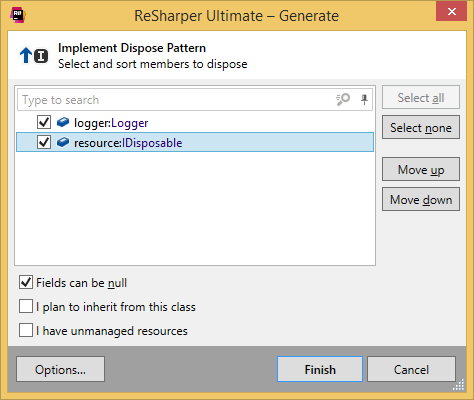Generate Dispose Pattern
ReSharper helps you automatically generate various implementations of IDisposable depending on kind of resources that your class owns:
If your class only owns managed
IDisposableresources, ReSharper will help you generate a simple implementation ofpublic void Dispose()without parameters, whereDispose()is called on selected disposable members.If your class only owns unmanaged resources, ReSharper will additionally generate destructor and a
ReleaseUnmanagedResourcesmethod where you could write your cleanup code.If your class owns or will potentially own (via inheritance) both managed and unmanaged resources, ReSharper will additionally create a
Dispose(bool disposing)method which could be overridden by the inheritors.
To configure how the disposable pattern is implemented, use option in the Generate dialog.
In the example below, this command is used to generate a disposable pattern for managed logger and resource fields, with a single option to generate null checks for these fields.
Before generation | After generation |
|---|---|
class MyClass
{
private Logger logger;
private IDisposable resource;
}
|
class MyClass : IDisposable
{
private Logger logger;
private IDisposable resource;
public void Dispose()
{
logger?.Dispose();
resource?.Dispose();
}
}
|
Generate a dispose pattern
In the editor, place the caret at the type name or within a type at the line where you want to insert a dispose pattern. If the caret is on the type name, the generated code will be added in the beginning of the type declaration.
Press Alt+Insert or choose from the main menu. Alternatively, you can press Control+Shift+A, start typing the command name in the popup, and then choose it there.
In the Generate popup, select Dispose Pattern.
In the Generate dialog that appears, you will see a list of private properties and fields of type assignable to
IDisposable. Select some or all of these type members, and ReSharper will generate wrappers in the current type that delegate execution to selected type members.
Optionally, use the following controls in the dialog:
Fields can be null — appears if there are any nullable fields or properties in your type. By default, this checkbox is selected, meaning that ReSharper will generate null checks for selected fields. You can clear this checkbox if you do not need null checks.
I have unmanaged resources — if this checkbox is selected, ReSharper will additionally generate destructor and a
ReleaseUnmanagedResourcesmethod where you could write your cleanup code.I plan to inherit from this class — if this checkbox is selected, ReSharper will additionally create a
Dispose(bool disposing)method which could be overridden by the inheritors.Dispose already exists — appears if an implementation of
Dispose()already exists and lets you choose whether to:Replace the method if it already exists.
Put the newly generated method side by side with the existing one.
Skip generating a new method altogether.
Destructor already exists — appears if you have chosen the I have unmanaged resources option and the class already has a destructor. Use this selector to choose whether to:
Replace the method if it already exists.
Put the newly generated method side by side with the existing one.
Skip generating a new method altogether.
Click Finish to complete the wizard.
You can also click Options to review or modify common code generation preferences on the page of ReSharper options.
This action is also available as a quick-fix if IDisposable is not implemented.

This feature is supported in the following languages and technologies:
The instructions and examples given here address the use of the feature in C#. For more information about other languages, refer to corresponding topics in the ReSharper by language section.